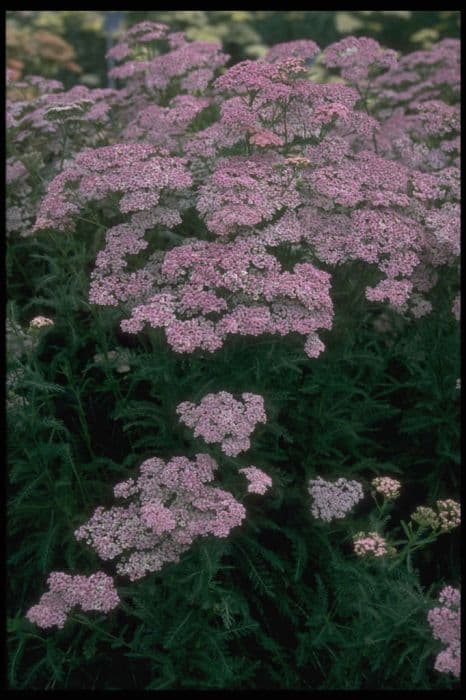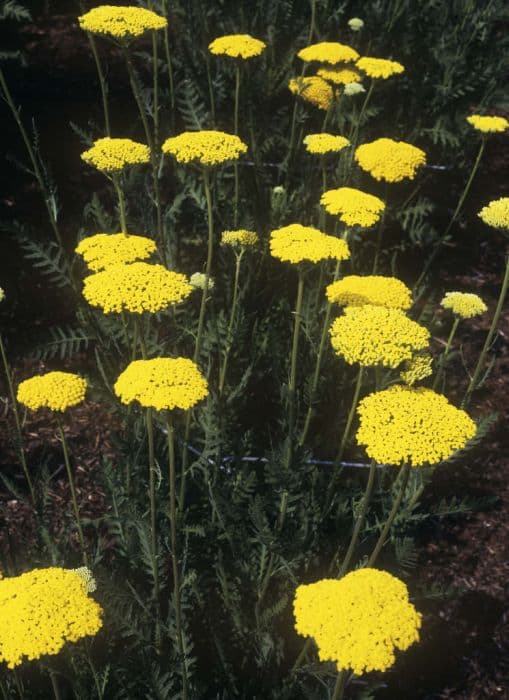Yarrow Achillea millefolium 'Lilac Beauty'

ABOUT
The Achillea millefolium 'Lilac Beauty', commonly known as Yarrow 'Lilac Beauty', is a striking perennial known for its beauty and resilience. This plant boasts a cluster of fern-like foliage that is aromatic when crushed. The leaves are finely dissected, giving them a delicate and intricate appearance, and they create a lush green backdrop for the flowers. The flowers of 'Lilac Beauty' Yarrow are its most notable feature. They are composed of numerous small, daisy-like blooms arranged in flat-topped clusters known as corymbs. The delicate petals exhibit a soft lilac shade, exuding a gentle and soothing aesthetic. As the name suggests, the 'Lilac Beauty' variant has a pastel purple tone, adding a splash of color to gardens throughout the blooming season. The blooming period of this yarrow typically occurs in the summer, during which time it becomes a hub of activity for pollinators such as bees and butterflies, drawn to its nectar-rich blooms. After the initial flowering, if deadheaded or trimmed back, 'Lilac Beauty' can continue to produce flowers until the early fall, providing a long-lasting display of color. Overall, the 'Lilac Beauty' Yarrow is an ornamentally attractive plant that exudes charm through its feathery foliage and lovely lilac flowers. It is a versatile addition to any garden, providing color and interest, along with a degree of drought tolerance and fuss-free maintenance.
About this plant
 Names
NamesFamily
Asteraceae.
Synonyms
Yarrow, Common Yarrow, Milfoil, Soldier's Woundwort, Thousand-Leaf, Nosebleed Plant, Devil’s Nettle, Old Man’s Pepper.
Common names
Achillea millefolium.
 Toxicity
ToxicityTo humans
Yarrow is generally not considered poisonous to humans, and 'Lilac Beauty' as a cultivar of Achillea millefolium falls under the same consideration. Many parts of the yarrow plant have been used traditionally in herbal medicine. However, some individuals may experience dermatitis or allergic reactions when coming into direct contact with the plant. Ingesting large quantities of yarrow could potentially lead to gastrointestinal discomfort, such as diarrhea or vomiting. It is advisable to exercise caution and avoid consuming yarrow in medicinal or culinary use without proper knowledge or guidance from a qualified expert.
To pets
Yarrow is not typically listed as highly toxic to pets but can cause mild to moderate gastrointestinal upset if ingested in significant amounts. Symptoms of yarrow poisoning in pets may include vomiting, diarrhea, drooling, or anorexia. Pets with a particular sensitivity to the plant might also experience skin irritation upon contact. While 'Lilac Beauty' is a specific cultivar of Achillea millefolium, the toxicity profile does not significantly differ from the common yarrow species. It is always best to prevent pets from ingesting plant material, especially from those not identified as safe for pet consumption.
 Characteristics
CharacteristicsLife cycle
Perennials
Foliage type
Deciduous
Color of leaves
Green
Flower color
Lilac
Height
2 feet [60 cm]
Spread
2 feet [60 cm]
Plant type
Herb
Hardiness zones
3
Native area
Europe
Benefits
 General Benefits
General Benefits- Attracts Pollinators: 'Lilac Beauty' is known to attract bees, butterflies, and other beneficial insects that aid in the pollination of nearby plants.
- Drought Tolerant: Once established, this variety of yarrow is quite resilient to drought, making it a good choice for water-wise gardens.
- Low Maintenance: Requires minimal care beyond initial planting and occasional watering, making it an ideal plant for low-maintenance landscapes.
- Deer Resistant: Its fragrance and foliage are typically unappealing to deer, reducing the likelihood of damage in areas with deer populations.
- Long Blooming: It has a long flowering season, generally from early summer to early fall, providing prolonged visual interest in the garden.
- Easy to Propagate: Can be easily propagated through division or cuttings, allowing gardeners to expand their plantings or share with others.
- Soil Improvement: Helps to build healthy soil by accumulating nutrients with its deep roots that can be released back into the soil when the plant dies back.
- Versatile Planting Options: Suitable for borders, rock gardens, or as ground cover, providing versatility in garden design.
 Medical Properties
Medical Properties- Anti-inflammatory: Yarrow is traditionally used to help reduce inflammation in the body.
- Hemostatic: It can be used to stop bleeding, both internally and externally.
- Antispasmodic: The plant may help to relieve spasms in the muscles.
- Carminative: Yarrow is known to help relieve gastrointestinal discomfort and reduce gas.
- Digestive: It may aid in digestion by stimulating the secretion of digestive enzymes.
- Diaphoretic: Yarrow may induce sweating and help reduce fevers by promoting perspiration.
- Astringent: The herb can be used topically to tighten skin or tissue and stop discharge.
- Antiseptic: Yarrow possesses properties that may prevent the growth of microbes and prevent infection.
- Anxiolytic: There is some evidence to suggest that yarrow can help reduce anxiety.
 Air-purifying Qualities
Air-purifying QualitiesThis plant is not specifically known for air purifying qualities.
 Other Uses
Other Uses- Companion Planting: Yarrow 'Lilac Beauty' can be planted alongside vegetables like tomatoes to attract beneficial insects and improve pollination.
- Soil Erosion Control: The extensive root system of yarrow can help stabilize soil and prevent erosion, especially on slopes or areas prone to water runoff.
- Natural Lawn Alternative: Yarrow can be used as a drought-tolerant lawn substitute, requiring less water and maintenance than traditional grass.
- Dye Production: The flowers of Yarrow 'Lilac Beauty' can be used to produce a range of colors for natural fabric dyes.
- Fish Composting: Yarrow can be added to compost piles that include fish scraps, to accelerate decomposition and reduce odors.
- Decorative Dried Flowers: Thanks to its sturdy structure, Yarrow 'Lilac Beauty' is excellent for use in dried floral arrangements and crafts.
- Culinary Garnish: The flowers and foliage of Yarrow 'Lilac Beauty' can be used to add color and a mild, peppery flavor as a garnish for culinary dishes.
- Biodynamic Gardening: Yarrow is often used in biodynamic preparations to enhance soil health and stimulate plant growth in an eco-friendly manner.
- Indicator Plant: Yarrow can indicate soil health; it thrives in low fertility soil, signaling the need for soil improvement.
- Insect Repellent: The plant’s aromatic qualities may help repel certain unwanted insects from gardens or outdoor living spaces.
Interesting Facts
 Feng Shui
Feng ShuiThe plant Yarrow is not used in Feng Shui practice.
 Zodiac Sign Compitability
Zodiac Sign CompitabilityThe plant Yarrow is not used in astrology practice.
 Plant Symbolism
Plant Symbolism- Healing: Achillea millefolium, commonly known as Yarrow, is named after Achilles, the Greek hero who was said to have used it to treat his soldiers' wounds. Consequently, yarrow symbolizes healing.
- Protection: Yarrow has been historically used to ward off negative energy and is believed to offer protective qualities, symbolizing safeguarding and defense.
- Courage: Linked with the warrior Achilles, yarrow is often associated with bravery and valor, reflecting the courage found in battles of old.
- Love and Attraction: Yarrow is sometimes used in love spells and is thought to be a powerful herb for attraction, representing the binding force of love.
- Divination: In the Middle Ages, yarrow was used for divination purposes, including I Ching rituals in China, symbolizing the ability to unveil the future or one’s path in life.
 Water
WaterYarrow 'Lilac Beauty' should be watered deeply but infrequently, as it is a drought-tolerant plant. The goal is to encourage the roots to grow deep into the soil. Typically, watering once a week with about one inch of water is sufficient, but this might need to be adjusted depending on local weather conditions and soil type. During hot, dry periods, you might need to water more often, while in cooler or rainy climates, less frequent watering may be needed. Always check the soil moisture before watering; it should be dry an inch below the surface before you water again.
 Light
LightCommon Yarrow 'Lilac Beauty' thrives best in full sun exposure, which means it needs at least 6 hours of direct sunlight each day to flourish. The ideal spot for this plant is in an area that receives unfiltered sunlight for most of the day. However, it can also tolerate partial shade, especially in the afternoon when the sun is most intense.
 Temperature
TemperatureYarrow 'Lilac Beauty' is a hardy plant that can tolerate a wide range of temperatures but performs best when the weather is between 65 and 75 degrees Fahrenheit. It can survive temperatures as low as 0 degrees Fahrenheit and as high as 90 degrees Fahrenheit. The plant is well-suited for growth in areas that experience significant temperature variations between night and day as well as throughout the seasons.
 Pruning
PruningPruning Yarrow 'Lilac Beauty' is important for encouraging new growth and more vigorous flowering. It should be pruned back by about one third after the first wave of blooming to promote a second bloom period. Deadheading, or removing spent flower heads, can be done throughout the growing season to keep the plant looking tidy and encourage more flowers. The best time for major pruning is in late fall or early spring when the plant is dormant.
 Cleaning
CleaningAs needed
 Soil
SoilCommon Yarrow 'Lilac Beauty' thrives in well-draining soil with a pH of around 6.0 to 7.0. A soil mix composed of garden soil, compost, and coarse sand or perlite will enhance drainage while providing essential nutrients. Ensure the soil does not retain too much moisture to prevent root rot.
 Repotting
Repotting'Lilac Beauty' Yarrow, being a hardy perennial, generally does not require frequent repotting. It is best to repot every 2-3 years or when the plant outgrows its current container, which allows for the refreshing of the soil and encourages healthy growth.
 Humidity & Misting
Humidity & Misting'Lilac Beauty' Yarrow prefers a dry to average humidity level. It is particularly tolerant of dry conditions, making it a suitable plant for areas with low atmospheric humidity and making it an easy-care plant in various environments.
 Suitable locations
Suitable locationsIndoor
Place in well-lit area and ensure pot has good drainage.
Outdoor
Full sun, well-draining soil, and space plants 1-2 feet apart.
Hardiness zone
3-9 USDA.
 Life cycle
Life cycleCommonly known as 'Lilac Beauty' Yarrow, Achillea millefolium 'Lilac Beauty' begins its life cycle when seeds germinate in early spring, requiring a period of cold stratification to break dormancy. Seedlings emerge and establish a rosette of feathery, fern-like foliage, from which stems will later grow. As the plant matures, stems elongate, and in late spring to early summer, clusters of lilac-pink flowers bloom atop the stems. These flowers attract pollinators and, after fertilization, develop into small, dry fruits known as achenes. Throughout summer, the plant may continue to produce blooms if spent flowers are removed, a process known as deadheading. In autumn, the plant dies back to the ground, becoming dormant over winter, ready to restart the cycle the following spring.
 Propogation
PropogationPropogation time
Spring to early summer
The common yarrow 'Lilac Beauty' can be propagated primarily through division, which is considered the most popular method for this plant. Division should be done in early spring or fall, when the plant's growth is not at its peak to avoid stressing the plant. To propagate by division, carefully dig up the entire yarrow plant, ensuring a good amount of the root system is intact. Gently separate the clumps into smaller sections, each having several shoots and adequate root systems. These sections can then be replanted at the same depth they were growing at previously, spacing them about 1 to 2 feet apart (approximately 30 to 60 centimeters). Water the new divisions well to help establish them. This method is both effective and simple, allowing for quick multiplication of your 'Lilac Beauty' plants while maintaining the health and vigor of your garden.









